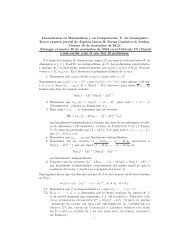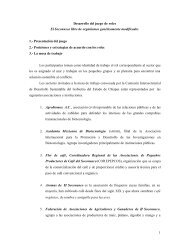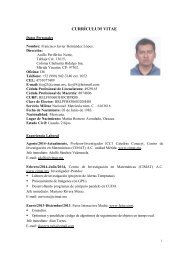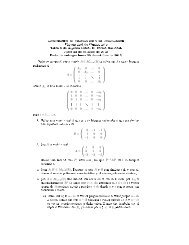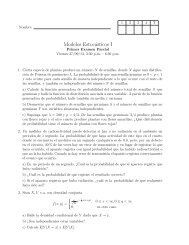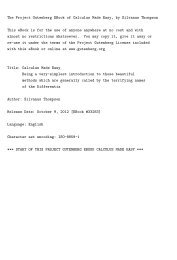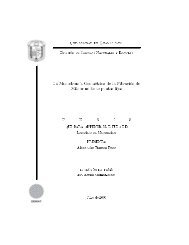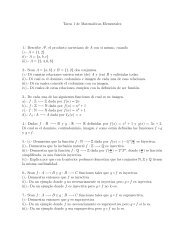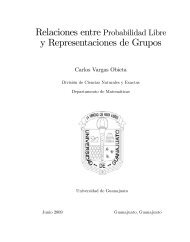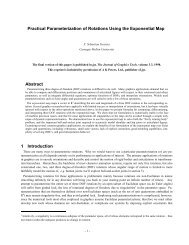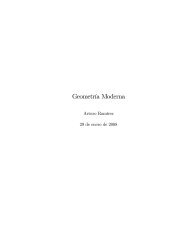We will compute a lower bound for the linear form (3.6.4) using the techniques fromSecti<strong>on</strong> 3.5. Observe that‖ε 3 /ε 1 ‖ υ = ‖ν 3ε 3 /(ν 1 ε 1 )‖ υ‖ν 3 /ν 1 ‖ υ.Combining this with Lemma 3.2.1 and (3.6.5) we get( )ν3 ε 3h ≤ 2H(s + 1) − s ∥ ∥ ∥∥∥ν 1 ε 1 d log ν 3 ε 3 ∥∥∥υ, (3.6.6)ν 1 ε 1and hence a lower bound for log‖ν 3 ε 3 /(ν 1 ε 1 )‖ υ will give an upper bound for h(ν 3 ε 3 /(ν 1 ε 1 )).Assume first that υ is infinite. SetA 0 = 2dH ≥ max(d h(α 0 ), π),⎧⎪⎨ max(d h(µ i ), π), i = 1, . . . , s 1 − 1,A i =⎪⎩ max(d h(ρ i−(s1 −1)), π), i = s 1 , . . . , s 1 + s 2 − 2.(3.6.7)Let n = s 1 + s 2 − 1. Since we assumed s 1 and s 2 to be ≥ 3, we observe that fromLemma 3.3.2andn−1∏i=1A i ≤ c 4 (s 1 , d 1 )c 4 (s 2 , d 2 )R 1 R 2 , (3.6.8)max1≤i≤n−1 A i ≤ max{c 2 (s 1 , d 1 )R 1 , c 2 (s 2 , d 2 )R 2 , π}. (3.6.9)We distinguish two cases. First assume thatB ≤ 2e max((s 1 + s 2 − 2)π/ √ 2, A 1 , . . . , A s1 +s 2 −2)A 0 .From Lemma 3.5.1 and equati<strong>on</strong>s (3.6.8) and (3.6.9) we have∥ logν 3 ε 3 ∥∥∥υ∥ > − 2d υ dHc 4 (s 1 , d 1 )c 4 (s 2 , d 2 )c 7 (n, d)R 1 R 2 ×ν 1 ε 1log( √ 2e max{(s 1 + s 2 − 2)π/ √ 2, c 2 (s 1 , d 1 )R 1 , c 2 (s 2 , d 2 )R 2 )}.(3.6.10)35
Next assume that B > 2e max((s 1 + s 2 − 2)π/ √ 2, A 1 , . . . , A s1 +s 2 −2)A 0 . Then, usingagain Lemma 3.5.1 and (3.6.8) we get the following bound.∥ logν 3 ε 3 ∥∥∥υ∥ > −2d υ dHc 4 (s 1 , d 1 )c 4 (s 2 , d 2 )c 7 (n, d)R 1 R 2 ×ν 1 ε 1log(B/(2 √ 2dH)).(3.6.11)Now assume υ is finite. Let p be a corresp<strong>on</strong>ding prime ideal to υ. Then∥ logν 3 ε 3 ∥∥∥υ∥ = − ord p (α b 00ν 1 ε µ−b 11 · · · µ −b s 1 −1s 1 −1 ρ f 11 · · · ρf s 2 −1s 2 −1 − 1) log N(p). (3.6.12)1Again, we distinguish two cases. First assume thatB < 4c 9 (n, d)H h(µ 1 ) · · · h(µ s1 −1) h(ρ 1 ) · · · h(ρ s2 −1).In this case we will directly compute an upper bound for h(ν 3 ε 3 /(ν 1 ε 1 )). From (3.6.4)and Lemma 3.3.1 we deduce that( )ν3 ε 3h ≤ log 2 + 2H + B(n − 1) max{c 2 (s 1 , d 1 )R 1 , c 2 (s 2 , d 2 )R 2 }.ν 1 ε 1Then, from our assumpti<strong>on</strong> for B and (3.6.2) we get( )ν3 ε 3h ≤ log 2 + 2H + 4(n − 1)Hc 1 (s 1 , d 1 )c 1 (s 2 , d 2 )c 9 (n, d)×ν 1 ε 1R 1 R 2 max{c 2 (s 1 , d 1 )R 1 , c 2 (s 2 , d 2 )R 2 }.(3.6.13)We next assumeB ≥ 4c 9 (n, d)H h(µ 1 ) · · · h(µ s1 −1) h(ρ 1 ) · · · h(ρ s2 −1).Since 2H ≥ 1 we have h ′ 0 = max{h(α 0), 1/(16e 2 d 2 )} ≤ 2H. Moreover, using Lemma3.2.4, for i = 1, . . . , s 1 − 1 and j = 1, . . . , s 2 − 1 we haveh ′ i = max{h(µ i ), (16e 2 d 2 ) −1 } = h(µ i ),andh ′ j+s 1 −1 = max{h(ρ j ), (16e 2 d 2 ) −1 } = h(ρ j ).36
- Page 1 and 2: S-integral <strong
- Page 3: 3.3 Systems of fundamental units .
- Page 6 and 7: AcknowledgmentsTo the glory of my G
- Page 8 and 9: DeclarationsI declare that, except
- Page 10 and 11: Chapter 1IntroductionConsider the h
- Page 12 and 13: As mentioned earlier, Step (I’) h
- Page 14 and 15: present an algorithm of Bost and Me
- Page 16 and 17: Chapter 2The Mordell-Weil groupThe
- Page 18 and 19: Denote the corresponding element of
- Page 20 and 21: of C is the logarithmic naive heigh
- Page 22 and 23: For the computation of the canonica
- Page 24 and 25: Once we find r linearly independent
- Page 26 and 27: then it should have strictly lower
- Page 28 and 29: integral p
- Page 30 and 31: and such that all y(P i ) are non-z
- Page 32 and 33: mapped to x − α (mod Q ∗ K ∗
- Page 34 and 35: the ring of integers of K is the us
- Page 36 and 37: Proof. Recall that ‖ε‖ υ = 1
- Page 38 and 39: Proof. Note that for any place υ i
- Page 40 and 41: We will also need a bound for the c
- Page 42 and 43: a large field, we get one in terms
- Page 46 and 47: Choose nowδ = 2c 9 (n, d)H h(µ 1
- Page 48 and 49: c ∗ 14 = 2H∗ d s 1+s 2 −2 P d
- Page 50 and 51: To ease notation we write A 1 + A 2
- Page 52 and 53: Let f(x) = x 5 − 16x + 8. Let α
- Page 54 and 55: 3.8 The Mordell-Weil sieveWe have g
- Page 56 and 57: of the first 22 primes. We transfor
- Page 58 and 59: The reader can find the MAGMA progr
- Page 60 and 61: The AGM of two positive real number
- Page 62 and 63: Note that sgn(t) does not change al
- Page 64 and 65: 4.2 Bost and Mestre’s algorithmIn
- Page 66 and 67: Lemma 4.2.4 (I-3). Let P, Q ∈ R[X
- Page 68 and 69: and[U, V ] = −2R∆(P, Q, R),[V,
- Page 70 and 71: andU(x) = [Q, R](x) = (b + b ′
- Page 72 and 73: then F 1 is precisely of degree 2 a
- Page 74 and 75: Lemma 4.2.10 (III-3-a). We have z 1
- Page 76 and 77: and∫ x0wS(z 1 (x))z ′ 1 (x)dxy
- Page 78 and 79: intervals whose endpoints</
- Page 80 and 81: C to the integrals
- Page 82 and 83: for [U n , V n ] and [W n , U n ],
- Page 84 and 85: Since I n converges, T n converges
- Page 86 and 87: and a sum of integral</stro
- Page 88 and 89: 2 = a 1a ′ 1 − b 1b ′ 1 + √
- Page 90 and 91: • Else do- PutandIH i = θ √⎧
- Page 92 and 93: and⎧⎪⎨ −1, (a n,i = b and x
- Page 94 and 95:
algorithm used for the multiplicati
- Page 96 and 97:
interested in. The roots of f are m
- Page 98 and 99:
assuming that the polynomial f defi
- Page 100 and 101:
the g × 2g matrix⎛∫∫∫ ⎞A
- Page 102 and 103:
curves with the point at infinity a
- Page 104 and 105:
We are now interested in the numeri
- Page 106 and 107:
conformed ourselves with estimates
- Page 108 and 109:
Let P be an integral</stron
- Page 110 and 111:
We will now find an upper bound for
- Page 112 and 113:
for the divisors D 1 = (−1, 1)
- Page 114 and 115:
Proof. Since c 16 > 0, then X(P ) i
- Page 116 and 117:
now want to estimate the height of
- Page 118 and 119:
and for all x ≤ −c 16max{ ∫ x
- Page 120 and 121:
andφ(2D i )2= (d i,1 , d i,2 ) ∈
- Page 122 and 123:
Again, by our assumption, the right
- Page 124 and 125:
The reader can find the MAGMA progr
- Page 126 and 127:
[8] Nils Bruin, Chabauty methods us
- Page 128 and 129:
[30] Serge Lang, Algebraic number t
- Page 130:
[51] Michel Waldschmidt, Diophantin



